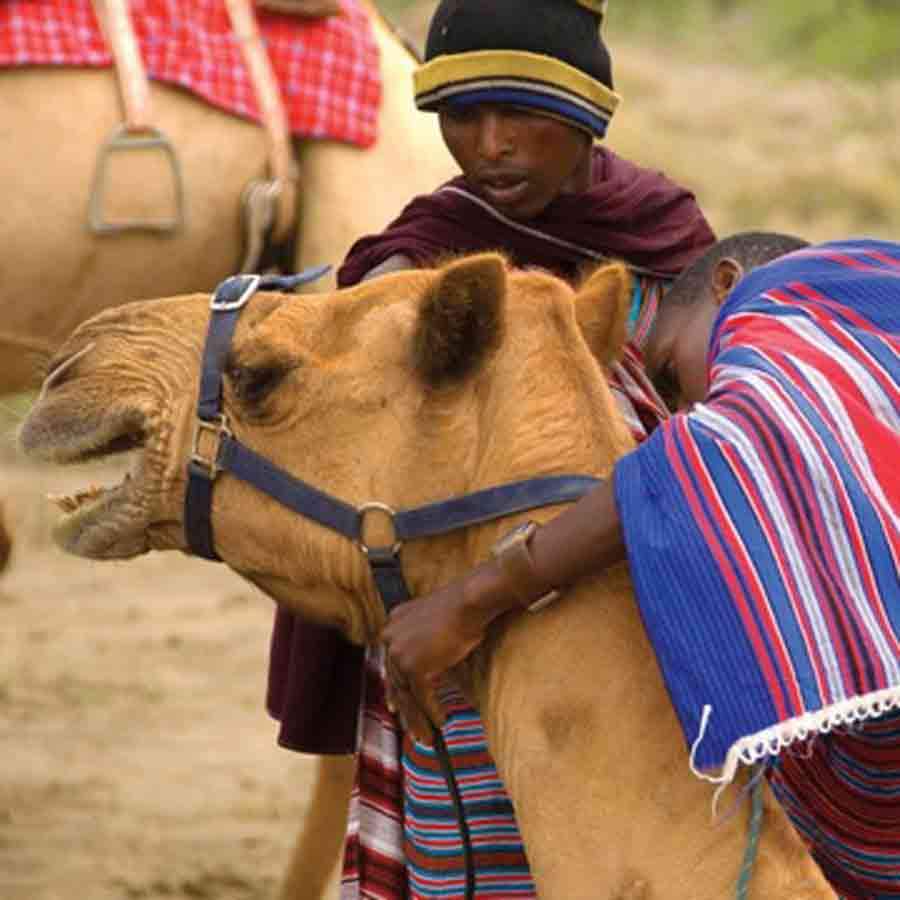A chant breaks the silence of a northern Tanzania rangeland. Soloists, in traditional Maasai regalia and dark sunglasses, belt out lyrics with high-pitched cries while the chorus utters its throaty replies. I crouch in the sand, close enough to feel the heat of a dozen dancers as they jump into the crowd, trying to outdo each other. Their fiery red clothing punctuates a sun-parched landscape of weathered acacia trees, sleep huts and rolling pastures on this humid March day, at the dawn of the rainy season.
The performance, which follows a tree-planting ceremony and a lavish buffet, marks the beginning of another season at the Mkuru Camel Safari camp. Built near its namesake village, the camp appears to be a cultural tourism success story.
“We are independent; we run the camp and safari by ourselves, with just a bit of support by the Oikos Institute in terms of human resources,” Issaya Shakweti, Mkuru’s program co-coordinator, explains.
“Every visitor coming to the camp pays a village development fee that goes straight to the community to improve schools and health services…Mkuru Camel Safaris employs only people from the community—all the cooks, security guards, cleaners and tour guides are from Mkuru village.”
“Culture must not be regarded as a relic; culture is changing and the changes must be channelled toward social development in accordance with traditional values.”
The Maasai settlement of Mkuru is located on the north side of Mount Meru in northern Tanzania. Camels, which aren't a traditional Maasai livestock, were introduced to the village in the 1990s by an organization called Heifer International. The safari project was relaunched when the Oikos Institute , an Italian NGO, provided an ecotourism expert. Now the Mkuru project is one of over 20 destinations marketed by the Tanzania Tourist Board’s cultural tourism programme, which also provides training in business management and tour guiding.
Mary Lwoga, the Tourist Board’s cultural tourism coordinator, says the programme brings money to some of the nation’s poorest communities, while providing a learning experience for visitors. “It enables tourists to experience the host’s way of life—an insight into values, beliefs and traditions—in the community’s own environment.”
Every year about 30,000 visitors to Tanzania participate in some kind of government-affiliated cultural tour, so the potential impact is massive. “If not carefully executed, it could lead to the erosion of cultures, customs and ways of life of local communities,” Lwoga warns.
Shakweti points out that culture is not static. “I hope to awaken [visitors] to the issues our community is facing,” he says. “Culture must not be regarded as a relic; culture is changing and the changes must be channelled toward social development in accordance with traditional values.”
“Taking tourists to a Maasai boma [a cluster of homes] is absolutely not enough,” he adds. “Tourists must be told what is going on. They must be involved and, if they can, must spread what they experience here when they go back to their countries, in order to challenge stereotypes.”
Lwoga agrees that visitors should participate. “Our product is not about just watching people in their daily lives. It is an experience that brings visitors and hosts closer as the former are guided through walks, hiking, trekking; they participate in some activities such as coffee processing, cooking and sharing meals; making handcrafts and sharing stories."
Aziz Athumani, an independent tour guide based in nearby Arusha, advises a buyer-beware mentality when choosing a tour. For example, in some popular areas of Tanzania, like Ngorongoro, visitors are taken to special tourist-only bomas that appear authentic, but the Maasai staff head home each evening to their real homes.
“The aim of cultural tourism is to enable visitors to learn more about Tanzania, but there are lots of people acting as coordinators who are not really promoting it, in its true meaning,” Athumani says, referring to the less authentic bomas. Corruption is another problem. Athumani points out that even though a tourist may be issued a receipt for paying a village development fee, the village may never receive any of the money or the benefits from the fees paid.
How do you evaluate cultural tourism opportunities and choose one that provides a positive experience for you and the host community? Asking these questions may help: Why has this village been chosen for cultural tourism? What are the specific challenges facing this village? Which community improvement projects are underway or planned? Who is responsible for implementing the projects? Why were these particular projects chosen? An ability to answer these questions with specific information is a sign that the tour guide knows something about the village. Official guides, who can be booked for a fair rate through tourist offices, are often locals who’ve undergone some training. They may even bring you home for tea.
Add this article to your reading list




